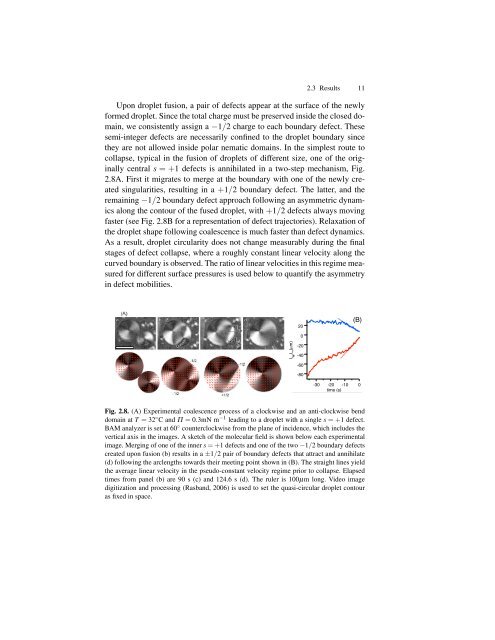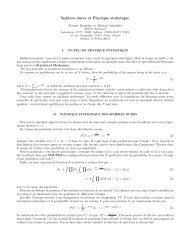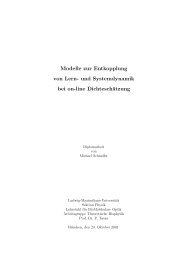Thesis (pdf) - Espci
Thesis (pdf) - Espci
Thesis (pdf) - Espci
Create successful ePaper yourself
Turn your PDF publications into a flip-book with our unique Google optimized e-Paper software.
2.3 Results 11<br />
Upon droplet fusion, a pair of defects appear at the surface of the newly<br />
formed droplet. Since the total charge must be preserved inside the closed domain,<br />
we consistently assign a −1/2 charge to each boundary defect. These<br />
semi-integer defects are necessarily confined to the droplet boundary since<br />
they are not allowed inside polar nematic domains. In the simplest route to<br />
collapse, typical in the fusion of droplets of different size, one of the originally<br />
central s =+1 defects is annihilated in a two-step mechanism, Fig.<br />
2.8A. First it migrates to merge at the boundary with one of the newly created<br />
singularities, resulting in a +1/2 boundary defect. The latter, and the<br />
remaining −1/2 boundary defect approach following an asymmetric dynamics<br />
along the contour of the fused droplet, with +1/2 defects always moving<br />
faster (see Fig. 2.8B for a representation of defect trajectories). Relaxation of<br />
the droplet shape following coalescence is much faster than defect dynamics.<br />
As a result, droplet circularity does not change measurably during the final<br />
stages of defect collapse, where a roughly constant linear velocity along the<br />
curved boundary is observed. The ratio of linear velocities in this regime measured<br />
for different surface pressures is used below to quantify the asymmetry<br />
in defect mobilities.<br />
-30 -20 -10 0<br />
time (s)<br />
! (C)<br />
!<br />
!<br />
" !<br />
!<br />
Fig. 2.8. (A) Experimental coalescence process of a clockwise and an anti-clockwise " bend<br />
domain at T = 32◦C and Π = 0.3mN m−1 leading to a droplet with a single s =+1 defect.<br />
BAM analyzer is set at 60◦ counterclockwise from the plane of incidence, which includes the<br />
vertical axis in the images. A sketch of the molecular field is shown below each experimental<br />
image. Merging of one of the inner s =+1 defects and one of the two −1/2 boundary defects<br />
created upon fusion (b) results in a ±1/2 pair of boundary defects that attract and annihilate<br />
(d) following the arclengths towards their meeting point shown in (B). The straight lines yield<br />
the average linear velocity in the pseudo-constant velocity regime prior to collapse. Elapsed<br />
times from panel (b) are 90 s (c) and 124.6 s (d). The ruler is 100µm long. Video image<br />
digitization and processing (Rasband, 2006) is used to set the quasi-circular droplet contour<br />
as fixed in space.<br />
L ,L<br />
+ -(µm)<br />
20<br />
0<br />
-20<br />
-40<br />
-60<br />
-80<br />
(B)




